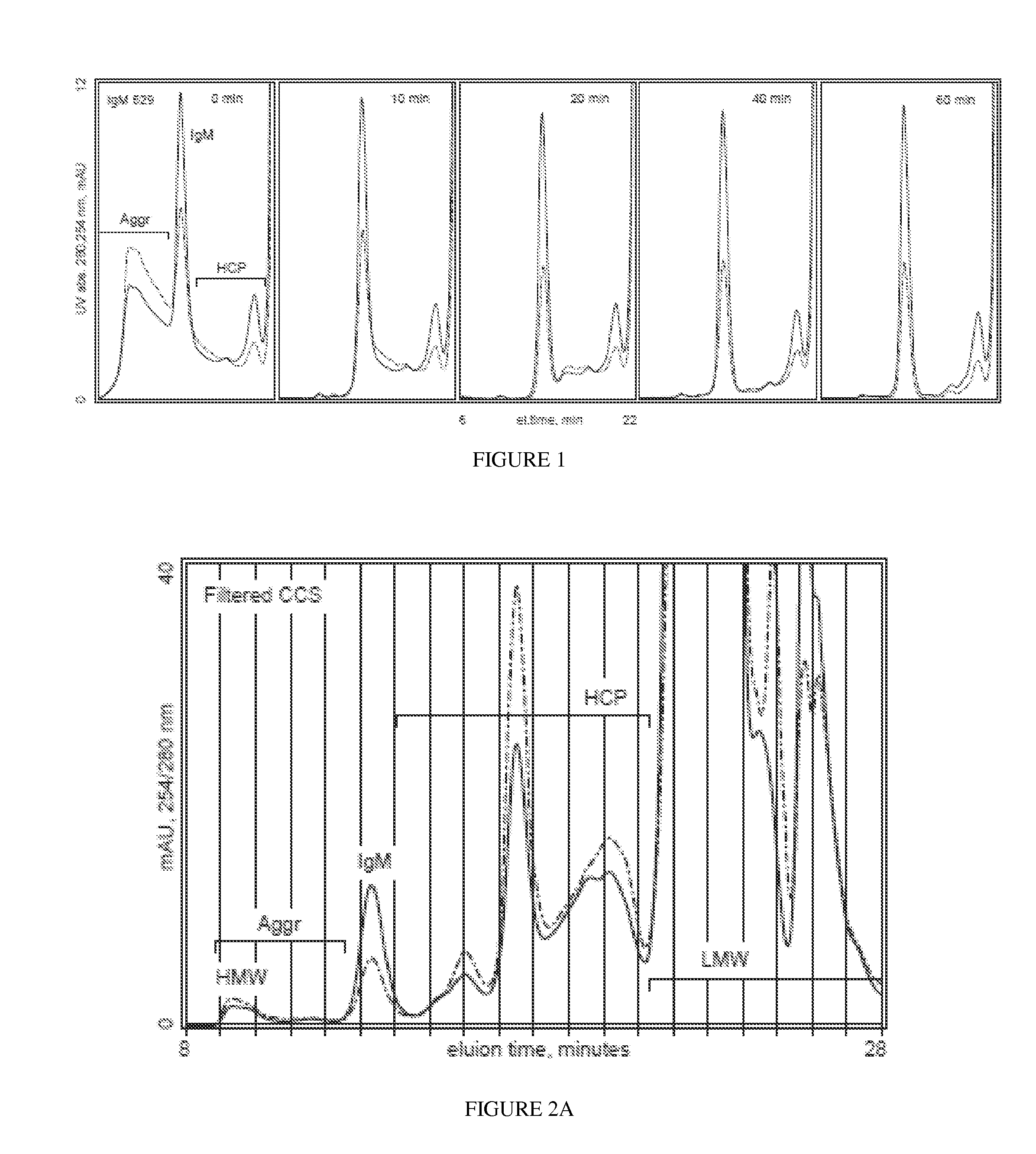Methods for use of mixed multifunctional surfaces for reducing aggregate content in protein preparations
a multifunctional surface and aggregate technology, applied in the field of protein purification materials, can solve the problems of ineffective treatment of antibody preparations with agents that might be expected to dissociate hetero-aggregates, ineffective anion exchange techniques, and inability to achieve the effect of reducing aggregate content and reducing aggregate content of samples
- Summary
- Abstract
- Description
- Claims
- Application Information
AI Technical Summary
Benefits of technology
Problems solved by technology
Method used
Image
Examples
example 1
[0185]Dissociation of DNA-antibody hetero-aggregates with integrated removal of DNA by treatment with a prototype mixture of electropositive and electronegative surfaces. Sodium chloride (NaCl) to a final concentration of 200 mM was added to 100 mL clarified cell culture supernatant containing monoclonal IgM clone 85 (conductivity 21 mS / cm). 2.5 mL of an electropositive macroporous particulate material (Nuvia Q) was mixed with 2.5 mL of an electronegative macroporous particulate material (Nuvia S), then sandwiched between polyvinylidene difluoride (PVDF) filters. The particles were equilibrated with 50 mM Hepes, 200 mM NaCl, pH 7.0. The sample was flowed through the particles, then chased with equilibration buffer. The particles were cleaned with 3 M guanidine. Untreated and treated sample were applied to an analytical size exclusion chromatography (SEC) column, monitored at 254 and 280 nm UV. The 254 / 280 ratio of the IgM peak in the untreated sample was 0.546, indicating that a sub...
example 2
[0186]Hetero-aggregate dissociation and removal of contaminants from an IgM preparation at elevated NaCl concentration. 100 mL of cell culture supernatant containing IgM 85 and with salt added to achieve a conductivity of about 25 mS / cm was passed over a prototype mixture of 0.25 mL each of a macroporous electronegative solid phase (Nuvia S), a macroporous electropositive solid phase (Nuvia Q), a microporous electropositive solid phase (Q Sephadex A25), and a microporous electronegative solid phase (CM-Sephadex C25), sandwiched between PVDF filters, and equilibrated with 50 mM Hepes, 250 mM NaCl, pH 7.0. Fractions were collected to determine efficacy. HMW aggregates and hetero-aggregates were essentially absent at sample loads up to about 20 mixed-particle volumes. More than 90% of the DNA was removed even at sample loads up to 100 particle volumes. These results demonstrate effective use of the invention at a conductivity value more than 30% higher than the minimum required to avoi...
example 3
[0187]Hetero-aggregate dissociation and removal of contaminants from an IgG preparation at elevated NaCl concentration. A monoclonal IgG, clone Her2, was found not to bind to electropositive media (Nuvia Q) even at conductivities below 1 mS / cm. It was found not to bind to electronegative media (Nuvia S) at conductivities above 12 mS (pH 7.0). The sample was raised to a conductivity of 15 mS and passed over the same prototype mixture as described in Example 2. DNA was removed, along with about half of the host protein contaminants. HMW aggregates were reduced from greater than 10% to less than 0.2%. Hetero-aggregates, as determined by 254 / 280 ratio, were essentially eliminated. This and the following experiments describing results with IgG monoclonal antibodies were performed using cell cultures that were grown to 50-80% mortality, which will be understood by persons experienced in the art to represent worst-case scenarios in terms of the content of aggregates and contaminants in the...
PUM
| Property | Measurement | Unit |
|---|---|---|
| pore size | aaaaa | aaaaa |
| pore size | aaaaa | aaaaa |
| conductivity | aaaaa | aaaaa |
Abstract
Description
Claims
Application Information
 Login to View More
Login to View More - R&D
- Intellectual Property
- Life Sciences
- Materials
- Tech Scout
- Unparalleled Data Quality
- Higher Quality Content
- 60% Fewer Hallucinations
Browse by: Latest US Patents, China's latest patents, Technical Efficacy Thesaurus, Application Domain, Technology Topic, Popular Technical Reports.
© 2025 PatSnap. All rights reserved.Legal|Privacy policy|Modern Slavery Act Transparency Statement|Sitemap|About US| Contact US: help@patsnap.com


